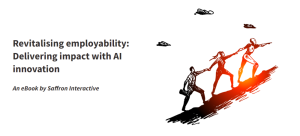An interesting debate has begun in our office of late – to storyboard or not to storyboard? I can almost hear the collective intake of breath that I dared even ask this question, but here at Saffron we are all about challenging norms and finding new solutions to old problems, so I’m going to push forward regardless.
To even begin a debate on this topic, we have to consider why storyboards appeared in the e-learning space to begin with. Typically used in the film industry, storyboards are a tool designed to simulate flow and movement, mapping out a story scene by scene. It’s a case of being able to see individual trees in detail, but then being able to stand back and appreciate the whole forest. The concept of storyboards relies heavily on the visual aspect, and is particularly useful to demonstrate a sequence: mapping out how the cops get the bad guy, or how Bambi and his mother are happily reunited after the near-fatal shooting – ok, well that one is more wishful thinking than reality, but you get my point.
In e-learning, storyboards are primarily a tool to help articulate your vision to a client. With them, you can show your client how their ideas and content have been streamlined into a smooth-flowing, engaging and educational course. As learning professionals, we already know that not everyone learns in the same way, and this of course is also true of clients. Having a visual representation in front of you can help to focus a client’s attention, giving them a sense of how a project is developing while gently steering them away from an information dump and towards an instructionally sound course. It’s all too easy to feel you haven’t quite explained exactly how to insert pin A into slot F while simultaneously pushing buttons D & E – but when you have a nice clear diagram storyboarded in front of you with a punchy little explanation, it is all the more easier to just let go.
So, storyboards are great then, right? Well, the short answer is ‘not always’. Sometimes the process of storyboarding can just add extra hours (and therefore costs) to an otherwise simple project. Just how much time do you put into a storyboard, and how much detail do you include? I have worked on projects where developing storyboards becomes almost a project in itself – complete with graphics, animated transitions and branding already incorporated. The clients love it, but it doesn’t do your project timelines any favours when the inevitable changes are requested. It’s also terribly easy to deviate from an in-depth analysis of content, and instead get caught up in the look and feel.
Like so much else, the key to storyboarding is striking a balance. Good storyboarding is about creating flow and mapping out the journey ahead – whether it’s for yourself or your client; on a piece of paper or in your head. It is about the process more than the tools – if you can clearly articulate your vision without a storyboard (and your client trusts you enough that they don’t need to see one) then great – you’ve just bought yourself extra development time. But if you feel that you might lose track and say, inadvertently re-write a key defining moment in a certain small deer’s life – then perhaps you’d better stick with more tried and tested methods.
I don’t think we have a one-size-fits-all solution to this one, but I’m really looking forward to continuing the debate. Don’t let me steer you in any one direction – what are your thoughts? What works for you?





